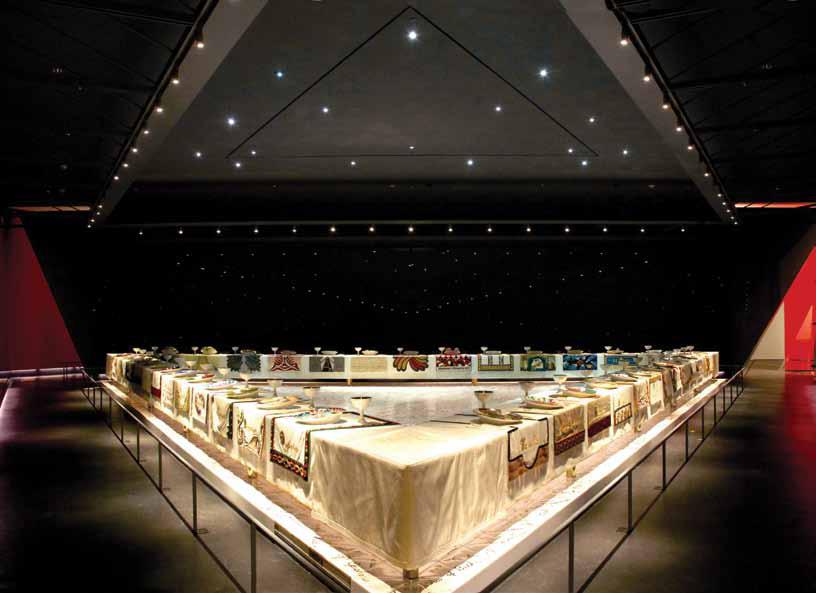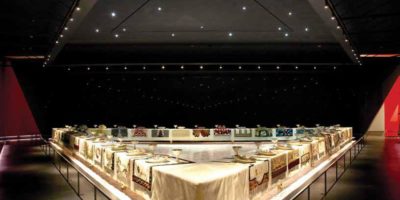Lilith Feature
A Philanthropist Gives Feminist Art What It Deserves
Feminist art — dismissed by most mainstream critics in the 1970s as kitsch or worse — is finally getting the reverent attention it deserves. The New York Times now calls it “the formative art of the last four decades,” with its activist energy, its pluralism, it homage to crafts and handiwork. It’s art with a component of special meaning for women’s experience, whether by a woman or a man (think Henry Moore), and it’s exploding into public consciousness thanks in large measure to two very public Jewish women, Judy Chicago and Elizabeth Sackler, and others we’ll soon come to know better: academics, curators, and artists themselves. Some germinal figures, like Judy Chicago and Miriam Schapiro, Lilith has brought to our readers’ attention for years. Now, major museum exhibitions plus countless smaller gallery shows, panels, conferences, articles, blogs and courses are bringing a whole new level of respect to this art that explores, celebrates and honors women’s lives, past and present. This art is no longer a risible stepchild (those menstrualblood paintings of the early 1970s didn’t help), and among the most important signals is that Judy Chicago’s monumental 1979 work. “The Dinner Party” now has a permanent home at the Brooklyn Museum, while a smaller, limited-time exhibition at Hebrew Union College in New York showcases her Jewish-themed feminist work.
“The Dinner Party” is an intimate ceramic-and-textile homage to 39 major female figures of the distant, middle and recent past (think goddesses, the biblical Judith, Emily Dickinson, Mary Wollstonecraft) has always been iconic, exciting, informative, and a visual and historical treat. I thrilled to these painted china plates and hand-embroidered runners 27 years ago when they first visited Brooklyn, and again when they reappeared at the Brooklyn Museum for a short stay in 2002. What’s different this time? The really glorious space that houses the work, and that tilts us toward a whole new era of honoring the power of this art to teach us — especially to teach us about women — in ways that feel very different from, say, the overtly political and constricted agenda-laden art of the Soviets.
The new home for “The Dinner Party” and for other exhibitions that will showcase the diversity of women’s visual expression is the Elizabeth A. Sackler Center for Feminist Art, which opened in March. Elizabeth Sackler bought “The Dinner Party” from Judy Chicago in order to place it at the Brooklyn Museum. No hands-off patron of the arts, Sackler had in mind the main gallery’s luminous ceiling and reflective glass walls, in order to engender a peak experience in the viewer. And it works; entering the gallery, designed by architect Susan Rodriguez, you feel you could be at Stonehenge, or in a gothic cathedral, or in the Rothko chapel in Houston. (Interesting that no Jewish space suggests itself in this short list… ) The setting facilitates the pleasure of seeing the plates and runners, synecdoche for the 39 dinner guests, joined by names of 999 other women painted onto the triangle’s white floor. In this noble space you realize how revolutionary it is for a costly, spare-no-detail center to announce that feminist art deserves to be housed so gorgeously.
A few weeks before the Center’s opening, photographer Joan Roth and I spent some time with both Elizabeth Sackler and Judy Chicago. Elizabeth Sackler and I talked in her office about the impulse behind the creation of the Center.
Lilith: On the paper sign taped on the wall over your head — a stand-in for what’s going to be on the museum’s wall — three parts are equally impressive: Elizabeth. Center. And feminist. First, it’s rare to see a woman’s name on a major institutional space. Then, it’s a “center” and not a temporary venue. Rarest of all, it’s labeled feminist.
Elizabeth Sackler: Thanks to Judy Chicago, in the late 1980s I knew why one had to have feminist art, not just women’s art, tying the work into the revolution. A revolution for women’s equality, justice, equity.
I started thinking in the late 1990s about a museum of feminist art, and I decided I had to put high-powered women on a list. So I called Katharine Graham of the Washington Post (she knew my father so she took my call), and had tea with her in Washington, and Hillary [Rodham Clinton], and had coffee with her in a little coffee shop around the corner from her husband’s office on 125th street.
Katharine Graham said, “I am not a feminist.”
Then I spoke to three or four other very public women. How can it be, I thought, that they are in power positions and that there is a disconnect between this and “feminist”?
One of these women asked, “Can’t you call it a museum for women’s art?” And for the first time in my life the hair on the back of my neck stood up. “No,” I told her. “It’s about feminist art — about the politics.” That was the first time I realized I was going to carry that torch, because there is a significant difference between women’s art and feminist art. I’m interested in creating a space that will bring people to an understanding of the accomplishments of women.
Lilith: Feminist is a scary word to a lot of people.
Sackler: I won’t give it that power!
Lilith: How did you get a museum to agree?
Sackler: My original idea was for the freestanding museum — the Elizabeth A. Sackler Museum for Feminist Art. But I realized it would have taken the rest of my life, worrying… I didn’t want to have to spend the rest of my life looking after another child… I already have two wonderful children. (I had great sperm donors for husbands.)
I looked for an institution, and at the way my father had partnered with institutions. I was taught — I learned — how to talk the talk with museums. This has not been done before because no woman knew how to do this. I made a spreadsheet of all the things I wanted and the Brooklyn Museum had the most checks on my list.
It took hard work and luck.
Lilith: Come on, Elizabeth — so often women attribute the good things they do, or their manifold accomplishments and successes, to “luck.”
Sackler: Well, the Brooklyn Museum said, “Can we use your name for a gallery?” No, I said — for a center for feminist art — not just a gallery.
Lilith: A lot of people would have been happy with just that!
Sackler: I thought about what I’d wanted for a freestanding museum — a roof of glass that’s opaque by day and you can see stars through it at night; that was my physical vision — a galaxy of stars and light. “The Dinner Party” gallery looks like this. When you walk into it you’re removed in time and space — space as extraordinary as “The Dinner Party” itself. It brings the women of “The Dinner Party” into a new relationship to the viewer — more grounded, more available, solid and strong.
Lilith: Let’s go back a minute. What first led you to identify as a feminist?
Sackler: I went to The New Lincoln School in Manhattan, a very progressive place. There was no anti-Semitism, no racism, no isms of any kind. And in my family there was no notion of anything other than equality; my father started the first interracial integrated blood bank. At 15, I was sleeping in front of the White House protesting for civil rights, voting rights; this was before the Civil Rights Act.
We’re Jewish. Jews have to be social activists. Ethics, morality — these were the interwoven fabric of my upbringing. My father was part of an intellectual group who had moved away from all observance. His Jewish identity was strong, but my father was a scientist, there wasn’t room for mysticism. Clearly, we were grounded in Jewish values.
Lilith: Most people would see your father’s legacy as a patron of the arts, not as an activist. The Sackler Gallery in Washington, the Sackler pavilion at the Metropolitan Museum housing the Temple of Dendur — all those highculture institutions. And in 1987 you took over as President of the Arthur M. Sackler Foundation. At what point did you own your power to make change?
Sackler: I was brought up to own my power to make change — by my parents, my education, by the city I live in. And I love doing it! I am in a place where I feel my power. And I’m doing what I was brought up to do.
Lilith: You have a Ph.D. in Public History, and a lot of what you’ve worked on has had to do with making sure that historical objects sacred to Indian tribes are repatriated — returned to their proper settings as venerated items — not sold on the auction block as art. And you’ve written about the need to restore Nazilooted art to its rightful owners. It seems to me that finding a permanent home for “The Dinner Party,” embedded in a place where study and public programs will take place too, is another kind of reclamation.
Sackler: The Center for Feminist Art is an extreme act of public history. My interest is to use “The Dinner Party” as a springboard into history, discussion, education. And this is the first time a girl will be able to walk into a gallery like this… We live in a patriarchal world. We don’t say it, people are uncomfortable saying it. We live in a patriarchy in this country, until there is a women’s revolution that will be complete. We’re not even asking for a matriarchy here. Just equality!
Lilith: Sounds almost old fashioned. And do you think your work in Brooklyn will be a role model for other women’s philanthropy?
Sackler: Now women are of an age, with resources. What comes out of this has to do with funding the revolution. In my case I described my vision to my mother and my older sister (she’s seven years older) and they stood by my side. As a result of the intelligent strategies of my sister and the economic resources of my mother (who passed away in 2000) I was able to create the Elizabeth A. Sackler Foundation.
Lilith: Judy Chicago says that she does not want to be remembered only for “The Dinner Party,” and you’re clear that though this is the centerpiece of the new Center there’ll be plenty of other things going on there, with exhibitions like “Global Feminisms.”
Sackler: I even envision this as a center for feminist writers — not limited to art and video — and not for the intellectual elite. That’s one of the good parts about being in Brooklyn. The space will be available to people of diverse backgrounds. And also a space for women not identified as feminists to speak out about not wanting to be ghettoized. I told the Brooklyn Museum that an important point is so that these dialogues can happen.



